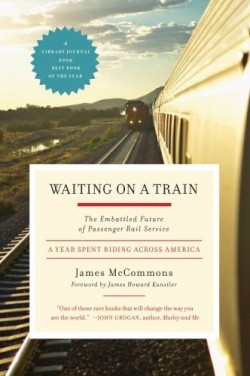Waiting on a Train
- 2009 INDIES Winner
- Silver, Social Sciences (Adult Nonfiction)
In the 1940s Chicago Union Station handled more than 300 trains and 100,000 passengers a day, writes journalism and nature writing teacher at Northern Michigan University James McCommons. He discusses railroading in America, and, while traveling 26,000 miles by rails in 2008 on such trains as the City of New Orleans and the Hiawatha, spoke with railroad experts, travelers, and employees.
The railroads were at their peak in the 1920s with 1,000 railroad companies operating 380,000 miles of track and carrying 1.27 billion passengers. At the same time, The Pullman Company, inventor of the sleeper car, was the largest “hotel operator” in the world, hosting 40,000 guests each night. John Hankey, a historian and one-time locomotive engineer, said, “The railroad was a reliable, efficient, high-capacity, all-weather, and democratic mode of transportation.” In the 1950’s, however, it began to decline as a result of the US government’s subsidization of the national highway system, inexpensive oil, and commercial air travel. In addition, the government thought “trains seemed old-fashioned.”
In the current “green era,” however, passenger trains are poised to help solve America’s transportation-energy problems. “Passenger trains consume seventeen percent less energy than airplanes and twenty-one percent less than cars for every passenger mile.” Inter-city passenger trains produce half the carbon dioxide per passenger mile than cars and airplanes. Trains are already on track: 28.7 million people traveled by Amtrak in 2008, an eleven percent increase from the year before.
Interspersed with information on the railroad industry are the author’s remembrances of his own train trips which keep the pace of this memoir hurling down the line. Aboard the Lake Shore Limited a group of Amish boarded at Sandusky and “swept down the aisle in black coats and hats; the women in black caps and bonnets. In the dark car, they were as black as crows in silhouette.” Near Denver on the California Zephyr, the author spoke with a Tokyo university professor who teaches nineteenth-century literature. “Melville is my line of study,” said he; he was heading for Boston to do research and saunter around Walden Pond.
Perhaps this book’s combination of facts and story will help another “Pullman hotel operation” rise again over the rails.
Disclosure: This article is not an endorsement, but a review. The publisher of this book provided free copies of the book to have their book reviewed by a professional reviewer. No fee was paid by the publisher for this review. Foreword Reviews only recommends books that we love. Foreword Magazine, Inc. is disclosing this in accordance with the Federal Trade Commission’s 16 CFR, Part 255.

